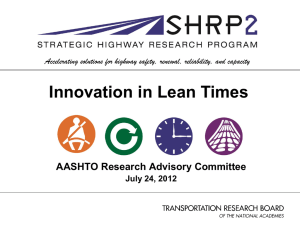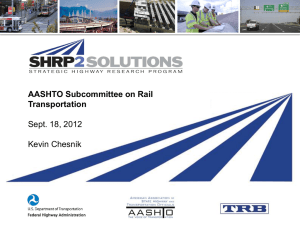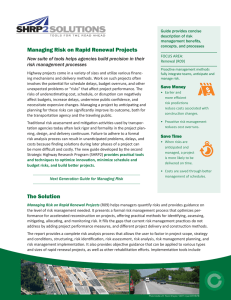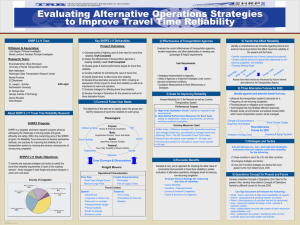Innovation in Lean Times
advertisement
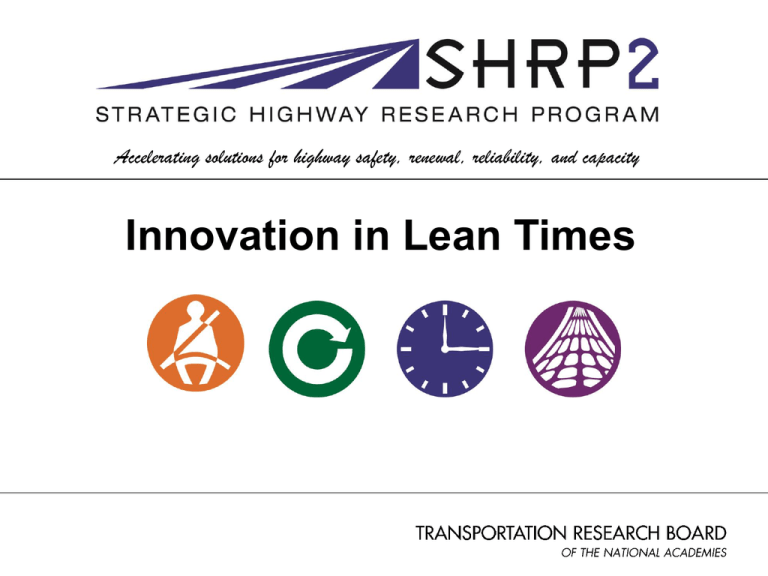
Accelerating solutions for highway safety, renewal, reliability, and capacity Innovation in Lean Times SHRP 2 Origin & Philosophy • Needs identified by State DOT and industry leaders—driven by customer-oriented goals: – Make highways safer: revolutionary change – Fix highways: address epidemic of aging infrastructure – Reduce congestion: increase physical and operational capacity • Success requires non-traditional approach: – Multiple disciplines – Collaboration with non-DOT stakeholders – Portfolio: from new knowledge to practical tools to allow existing innovations to be more widely used Four Focus Areas • Safety: fielding the largest-ever naturalistic driving study to reduce crashes and save lives through understanding driver behavior • Renewal: making rapid, innovative construction possible for “ordinary” projects • Reliability: Providing management and technical tools to reduce congestion through operations • Capacity: Systematizing collaborative decision making to achieve better, faster project decisions Safety: Strategic Rationale • Driver behavior is key: – Primary factor in two-thirds of crashes – Contributing factor in more than 90% of crashes – Hardest to study; the thing we know the least about • Opportunity: Naturalistic Driving Study (NDS): – Miniaturized sensor technologies & increased computing capacity: can observe real-world driving – Method proven with 100 car study at VA Tech – Crash, pre-crash, near-crash, and “normal” driving data • SHRP 2 scales up NDS for more robust results – 3000+ drivers, 6 sites, all ages – Data to be available for other researchers for decades Camera Image Samples Source: VTTI 5 Safety Highlights • Progress on data collection: – – – – 3,100 participants so far 4.3 million trips; 5 veh-yrs of data per day 12,500 center-line miles of roadway data Approval to collect cell phone records and “supplemental” data • First three analysis projects underway • Interest in using data from outside of SHRP 2 (FHWA, NHTSA, auto mfrs, academics, IIHS, AAA FTS, etc.) Initial Analysis Projects • Rural 2-lane curves – Iowa State University – Ex. App : more cost-effective roadway measures to prevent crashes • Offset left-turn bays – MRI Global – Ex. App: cost-effective intersection design • Driver inattention – SAFER, Chalmers Univ. – Ex. App: vehicle technology to track driver attention, warn distracted drivers 7 Renewal: Strategic Rationale • Facilities are aging, users depend on them: – Renew infrastructure quickly – Have minimal impact on users – Produce long-lasting facilities • We know how to do this—on special projects • What keeps us from doing it consistently across the system? – Lack of standard methods, specs – Lack of reliable performance/usage information – Human/institutional challenges • SHRP 2 seeks to overcome these obstacles Priority Renewal Projects • Bridges – R04 Bridge Designs for Rapid Renewal – R19A Bridges Beyond 100 Years • Pavements • R05 Modular Pavement Solutions • R21 Composite Pavement Systems • R23 Long-Life Pavements • R26 Preservation on High Volume Roadways Priority Renewal Projects • Project Management Tools – R07 Performance Specifications for Rapid Renewal – R09 Managing Risk in Rapid Renewal Contracts – R10 Managing Complex Projects • Non-Destructive Testing – R06 Web Tool for Non-Destructive Testing • Utilities and Railroads – R15B Integrating Utility/Transportation – R16 Railroad Agreements Reliability & Capacity Capacity tackles recurring congestion Reliability tackles nonrecurring congestion Reliability Strategic Rationale • Nonrecurring events account for more than half of congestion – Impact of these events on users is reduced travel time reliability (TTR) – TTR is valuable to users – TTR is a good tool to measure performance and develop and target improvements • What do we need to effectively use TTR? – Ways to measure and monitor TTR – Integration of TTR into modeling, planning, programming, and design. – Ops-oriented business practices, training Priority Reliability Projects • L12 Training for Traffic Incident Responders • Organizing for Reliability – – – – L31 L17 L06 L01 CEO Workshop on Operations Knowledge Transfer System Organizing Agencies for Systems Operations and Mgt. Business Processes for Reliability • Reliability Analysis Tools – – – – L02 L05 L07 L08 Monitoring Programs for Reliability Planning/Programming for Reliability Reliability by Design Reliability in the Highway Capacity Manual • L36 Regional Operations Forum Capacity Strategic Rationale • Sometimes you just need more highway • Why don’t we get it when we need it? – Multiple independent decision points that must collectively satisfy a range of goals: engineering, economic, environmental, community – Decisions tend to be “lost” or revisited, which can cause opposition and delay • Facilitate and expedite key decisions: get the right information to the right people at the right time, avoid re-do loops Priority Capacity Projects • C06 Integrating Ecosystem & Highway Planning • TCAPP – C01 TCAPP – C02 Performance Measures – C19 Expedited Project Delivery • Economic Impact Tools – C03 Economic Impact Case Studies – C11 Economic Impact Analysis Tools • C10 Travel Demand and Network Models • C15 Freight Planning Guide Research to Implementation Research Research responds to known transportation challenges Development A research product emerges and is refined through pilots and other activities Potential implementation explored through knowledge transfer Implementation Partner agencies select, prioritize, and prepare product for implementation Product is marketed to users and integrated into standard practice 16 MAP 21 and SHRP 2 • MAP 21 authorized funding for SHRP 2 implementation • $11 million of additional FFY 2012 funding • FFY 2013 and 2014 funding had to come from Statewide Planning and Research (SPR) funds agreed to by 3/4 of the states • 4% of SPR funds being used for SHRP 2 implementation • FHWA is providing additional funding • Funding for implementation more than doubled to $169 million • FHWA and AASHTO have developed a new implementation plan • More products were added, as well as funding added for products already in the plan SHRP2 SHRP2 Implementation Assistance Program FHWA Implementation Assistance Program Opportunities for implementation assistance • Proof of Concept Pilots • Lead Adopter Incentives • User Incentives Timeline • Application process through FHWA – First round solicitation of interest ended March 22, 2013 – Reviews and awards announced on Friday, May 3 – Second round underway 19 Products Included in First Round of Implementation Funding Assistance Capacity • Implementing Eco-Logical (C06) Renewal • Next-Generation Project Management Tools (2 products) – Managing Risk in Rapid Construction Projects(R09) – Managing Complex Projects (R10) • Bridge Designs for Rapid Renewal (R04) • Preservation on High-Volume Roadways (R26) Reliability • Organizing for Reliability Tools (L01/L06) 20 Implementation Opportunities • 34 States and the District of Columbia • 108 different transportation projects – Two proof of concept pilots – 74 lead adopter incentives – 24 user incentives – Limited technical assistance for 8 States 7/11/2016 21 Products Included in Second Round of Implementation Assistance Capacity • Expedited Project Delivery (C19) Renewal • Performance Specs for Rapid Renewal (R07) • Managing Risk in Rapid Construction Projects (R09) • Railroad Agreements (R16) 22 SHRP2 on the Web • SHRP2 @AASHTO – http://SHRP2.transportation.org – SHRP2 product fact sheets and collateral – Focus on AASHTO members • SHRP2@ TRB www.TRB.org/SHRP2 Comprehensive info about research phase • goSHRP2 @ FHWA www.fhwa.dot.gov/goSHRP2 – Information clearinghouse for SHRP2 implementation phase 23 – Links to other SHRP2 websites
